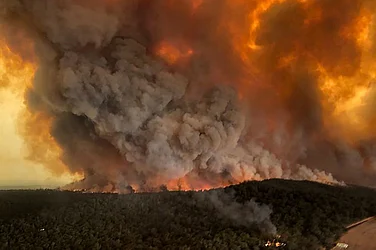India is recording the highest growth rate in carbon emission among the world’s major warming contributors, even as its per capita carbon emission remains significantly lower than many developed and developing nations, revealed a report titled Global Carbon Budget, published during the ongoing COP27 climate conference in Egypt on Friday.
According to the report’s estimates, in 2022, China and the European Union (EU) are projected to reduce their emissions by .9 per cent and .8 per cent, respectively, while India’s emissions are to increase by 6 per cent and the US’s by 1.5 per cent. The increase for the rest of the countries together was projected at 1.7 per cent.
In the last 10 years, India and China have recorded the highest emission growth rate, the report pointed out. “China’s emissions increased by 1.5 per cent per year on average over the last 10 years, dominating the global trend, and India’s emissions increased by 3.8% per year, while emissions decreased in the EU by 1.8 per cent per year and in the US by 1.1 per cent per year,” it said.
The report, involving an international team of more than 100 scientists, has been produced by Global Carbon Project, a research project working to quantify global greenhouse gas emissions and identify their causes.
While India continues to be the fourth largest global emitter, after China (31 per cent), the US (14 per cent), and the European Union, a media release regarding the report showed that India has nearly matched the share of the European Union made of 27 countries. India’s total emissions in 2021 have been pegged at 2.7 billion tonnes, which is slightly below the EU’s total of 2.8 billion tonnes. India’s 2021 share of global emissions stood at 7.5 per cent, marginally below the EU’s 7.7 per cent. In 2022, India’s share is projected to reach 8 per cent.
However, despite India’s relatively higher emission growth rate, the country’s per capita emission is still substantially lower than the three other major contributors.
In the list of top 20 global emitters in 2021, India’s per capita emission of 1.9 tonnes in 2021 stood right at the bottom, even behind Indonesia (2.3), Brazil (2.3), Mexico (3.2), and Vietnam (3.3), said a media release distributed on the occasion of the launch of the report. Saudi Arabia (18.7), the US (14.9), Australia (15.1), Canada (14.3), Russia (12.1), and South Korea (11.9) are the countries with the highest per capita emissions.
This means people in India, on average, have less access to power when compared to other major developed or developing regions.
Even going by per capita emission from fossil fuel alone, India stands far below. “The per capita fossil CO2 emissions in 2021 were 1.3 tC per person per year for the globe and were 4.0 (USA), 2.2 (China), 1.7 (EU27), and 0.5 (India) tC per person per year for the four highest-emitting countries,” the report said.
The Global Scene
The report said that globally, fossil CO2 emissions growth is slowing, owing to the emergence of climate policy and technological change, leading to a shift from coal to gas, growth in renewable energies, and reduced expansion of coal capacity. Nevertheless, 2022 records an increase in fossil CO2 emissions over 2021, currently standing slightly above the pre-Covid-19-pandemic level.
“Global carbon emissions in 2022 remain at record levels – with no sign of the decrease that is urgently needed to limit warming to 1.5°C… If current emissions levels persist, there is now a 50 per cent chance that global warming of 1.5°C will be exceeded in nine years,” the media release said.
According to Pierre Friedlingstein, the lead author of the report, despite some observable positive signs, leaders meeting at COP27 will have to take meaningful action to have any chance of limiting global warming close to 1.5°C above the pre-industrial level.
“The Global Carbon Budget numbers monitor the progress on climate action and right now we are not seeing the action required,” said Friedlingstein, a Fellow of the Royal Society who holds a Chair in Mathematical Modelling of the Climate System at the University of Exeter.
It projected global emissions to increase in 2022 by 1 per cent above 2021, with 2.2 per cent increase in emissions from oil and 1 per cent increase from coal, while emissions from natural gasses and cement are projected to slightly decrease.
However, for India, emission from natural gasses is projected to decrease by 4% but emissions from coal, oil and cement are likely to increase by 5 per cent, 10 per cent, and 10 per cent, respectively. It’s the increase from coal that principally drives India’s emission increase, a media release regarding the report said. The decline in emissions from natural gas contributes little to the total change as gas is a small part of the energy mix in India.
India: Growth and growing energy demand
Speaking to Outlook about the data presented by the reports, energy economist Vibhuti Garg said that India’s higher carbon emission is “very much linked to India’s higher GDP growth rate.”
“India's GDP is growing at 7-8 per cent annually and is likely to grow by 6-7 per cent in the next few years. This economic growth is driven by industrialisation and urbanisation, which is putting more pressure on energy demand. Given India has its own domestic coal resources, it is exploiting and mining more such resources,” said Garg, South Asia director at the Institute for Energy Economics and Financial Analysis (IEEFA),
According to her, India, with its increasing population and urbanisation and industrialisation, needs to make sustainable energy choices, meeting the increasing energy demands through a low-carbon pathway.
“India, while not compromising energy security and other social objectives, should increasingly look at harnessing local renewable energy resources. Also, India has to import more than 80 per cent of its oil and 50 per cent of gas, which in the last few months have proven to be expensive and unreliable. Generation based on fossil fuels is expensive and carbon-intensive. India can leapfrog in building clean energy alternatives to meet its energy demand,” she said.
India, in its Nationally Determined Contributions (NDC) to cut emissions and adapt to climate impacts, has pledged to “reduce the emissions intensity of its GDP by 45 per cent by 2030, from 2005 level, and achieve about 50 percent cumulative electric power installed capacity from non-fossil fuel-based energy resources by 2030.”
Given that India’s Central Electricity Authority projected the country’s cumulative installed capacity to be at 817 gigawatts (GW) in 2030, the country should have about 410 GW of installed capacity from renewable energy sources, including solar, wind, large hydro and biomass projects. Given that India’s renewable energy installed capacity stood at 160 GW in June, the country will need to increase it by two and a half times by the next eight years.
Meanwhile, the installed capacity of power from coal is also likely to increase by 56 GW – from 210gw in June to 266gw in 2029-30.
The Global Carbon Budget report, however, shows that India is not the only country where emissions from coal are projected to increase. “Coal emissions (41 per cent of global emissions) are projected to rise 1.0 per cent, with rises in India, the European Union, and the rest of the world, partly compensated by a drop in the USA and China,” it said.


























